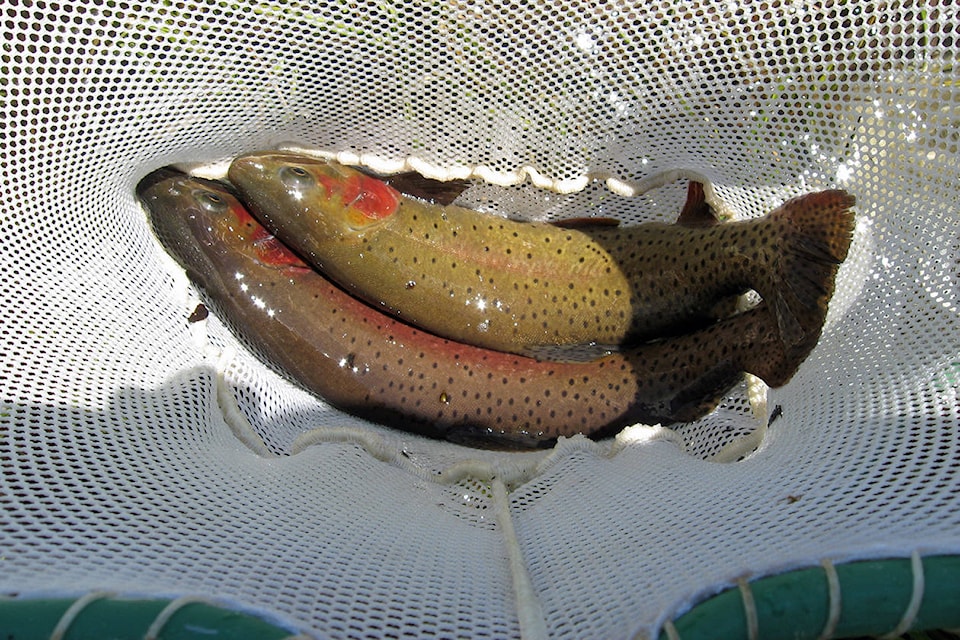Provincial fisheries officials are contemplating both fishing and bait ban extensions on the Kitimat River at certain times of the year to safeguard its coastal cutthroat population.
Chief among the proposals is a complete annual fishing ban on the river and its tributaries from Jan. 1 to March 31, a period that coincides with the coastal cutthroat trout’s overwintering period, indicates a document prepared by the Skeena fisheries section of the Forests, Lands and Natural Resource Operations ministry.
That fishing ban would also be extended from April 1 to May 31 but only on the Kitimat River above the Kitimat River Bridge as well as its tributaries.
And a bait ban would be in place from April 1 to August 31 and from Nov. 1 to Dec. 31.
“Kitimat CCT (coastal cutthroat trout) are highly vulnerable to capture and mortality during the overwintering period while they are aggregated in easily accessible and well-known locations,” reads a portion of the provincial document.
There’s also concern the coastal cutthroat have a high spawning mortality which “may be linked to repeat capture rates during the winter fishery.”
The overall fishing ban would end on March 31 when the cutthroat begin migrating from overwintering habitats, the document adds.
Coastal cutthroat “will be less vulnerable to anglers after March 31 while still providing a fishery opportunity coinciding with the entry of spring-run steelhead into the Kitimat [River] after April 1, for which a significant fishery exists,” the document states.
Instituting a bait ban as of April 1 (it’s now in place as of May 15) to August 31 and from November 1 to December 31 would reduce deaths and repeat capture rates of spawning coastal cutthroat and wild steelhead.
“We will be maintaining opportunity for a bait fishery to occur for coho salmon in September and October while reducing the angling mortality and repeat capture rates for coastal cutthroat entering the Kitimat River in late fall, after the coho fishery ends,” the document states.
An additional measure to safeguard cutthroat trout would be to encourage anglers to fish for hatchery-raised rainbow trout, putting in place a daily quota of five with no minimum size.
That’s to counter an increase in the number of hatchery-raised rainbow trout who stay in the river and compete for space and sustenance with cutthroat, indicates the document.
“The ministry wishes to mitigate impacts to Kitimat coastal cutthroat by promoting the harvest of resident hatchery rainbow trout,” the document states.
Concerns about the Kitimat River’s coastal cutthroat population have existed for years and were the subject of a UNBC master’s thesis by Eric Vogt whose findings figured in the proposed regulations being forwarded by provincial fisheries officials. The Habitat Conservation Trust Fund helped finance studies of the species three years ago.
And because the proposed changes would affect current regulations for chinook, coho and chum salmon, which are a federal responsibility, federal authorities would also need to change their own regulations.
Veteran angler Jim Culp from Terrace who sits on the Skeena Angler Advisory Team, a volunteer group which meets annually with fisheries officials and which reviewed the proposals this spring, said the measures are needed.
“Cutthroat are a gorgeous fish, but they’re very vulnerable,” said Culp of the species. “I would say the Kitimat River is one of the top rivers in B.C. for cutthroat and people are starting to respond.”
“And now it’s time to do something about protecting these fish.”
Culp noted that the proposed measures are backed by scientific studies.
He’s particularly pleased about the bait ban extension proposal, noting that mortality rates are high for catch and release because cutthroat will take a baited hook deep into its mouth.
“With bait, the fish is just so vulnerable,” said Culp. “I just don’t see too much opposition to the bait ban. Conservation is the main goal.”
But where there was much discussion at the spring advisory team meeting was the proposal to ban all fishing on the Kitimat River for the month of March, said Culp.
Although historical data indicates that March angling guide days on the river make up less than 0.25 per cent of annual guiding activity, Culp said the closure of the Skeena River to fishing this year will have guides going elsewhere, including the Kitimat.
“I would say [closing for March] was the biggest issue,” said Culp. “But when you look around, it’s about the future.”
A statement from the ministry stressed that the proposed changes are now being reviewed “and there may be additional revisions to the proposal to minimize the effect on other fisheries.”
“If the proposal is forwarded for consideration, it will make it to public engagement in the fall and if approved, will be implemented in the next regulation cycle for 2019/21,” the statement indicated.
